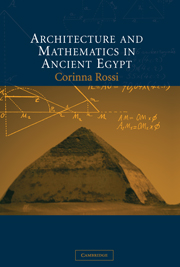Book contents
- Frontmatter
- Contents
- List of illustrations
- List of tables
- Preface
- Acknowledgments
- List of abbreviations
- Part I Proportions in ancient Egyptian architecture
- Introduction to Part I: Harmony and proportions in architecture
- 1 In search of ‘the rule’ for ancient Egyptian architecture
- 2 Mathematics and architecture in ancient Egypt
- Conclusion to Part I: Ancient mathematics and practical operations
- Part I Ancient Egyptian sources: construction and representation of space
- Part III The geometry of pyramids
- Conclusion to Part III: Interpreting the slope of pyramids
- An overview
- Appendix: List of Old and Middle Kingdom true pyramids
- Bibliography
- Index
Conclusion to Part I: Ancient mathematics and practical operations
Published online by Cambridge University Press: 27 February 2010
- Frontmatter
- Contents
- List of illustrations
- List of tables
- Preface
- Acknowledgments
- List of abbreviations
- Part I Proportions in ancient Egyptian architecture
- Introduction to Part I: Harmony and proportions in architecture
- 1 In search of ‘the rule’ for ancient Egyptian architecture
- 2 Mathematics and architecture in ancient Egypt
- Conclusion to Part I: Ancient mathematics and practical operations
- Part I Ancient Egyptian sources: construction and representation of space
- Part III The geometry of pyramids
- Conclusion to Part III: Interpreting the slope of pyramids
- An overview
- Appendix: List of Old and Middle Kingdom true pyramids
- Bibliography
- Index
Summary
As I have shown in Part 1, concepts like φ or π did not belong to ancient Egyptian mathematics and therefore could not be used by the ancient Egyptian architects. Their presence in the plans of ancient buildings is mainly due to our modern interpretation of the geometrical figures that compose the plan on paper. However, I am not arguing that mathematics was not involved in ancient Egyptian architecture, but rather that so far we have analysed cases in which the wrong mathematical system was adopted. Before we move on to an analysis of the ancient Egyptian architectural documents on planning and building, we must consider a final point: the supposed existence of a secret knowledge, restricted to a few initiated, concerning rules and symbolic meanings that would have been hidden in some buildings.
In theory, a project might be laid out on the basis of extremely complicated concepts and then the actual construction carried out with a certain degree of approximation. It is also true, however, that ancient Egypt does not reveal evidence for this discrepancy (in fact, I wonder how many other cultures actually do?). At any rate, the total lack of evidence has never prevented people from suggesting more or less complicated theories. Architecture may have a strong symbolic function, and in theory it is possible to suggest that, in their buildings, ancient Egyptian architects hid meaningful mathematical relationships, not immediately perceptible and related to an esoteric knowledge. Such a hypothesis is extremely difficult to test.
- Type
- Chapter
- Information
- Architecture and Mathematics in Ancient Egypt , pp. 87 - 90Publisher: Cambridge University PressPrint publication year: 2004



